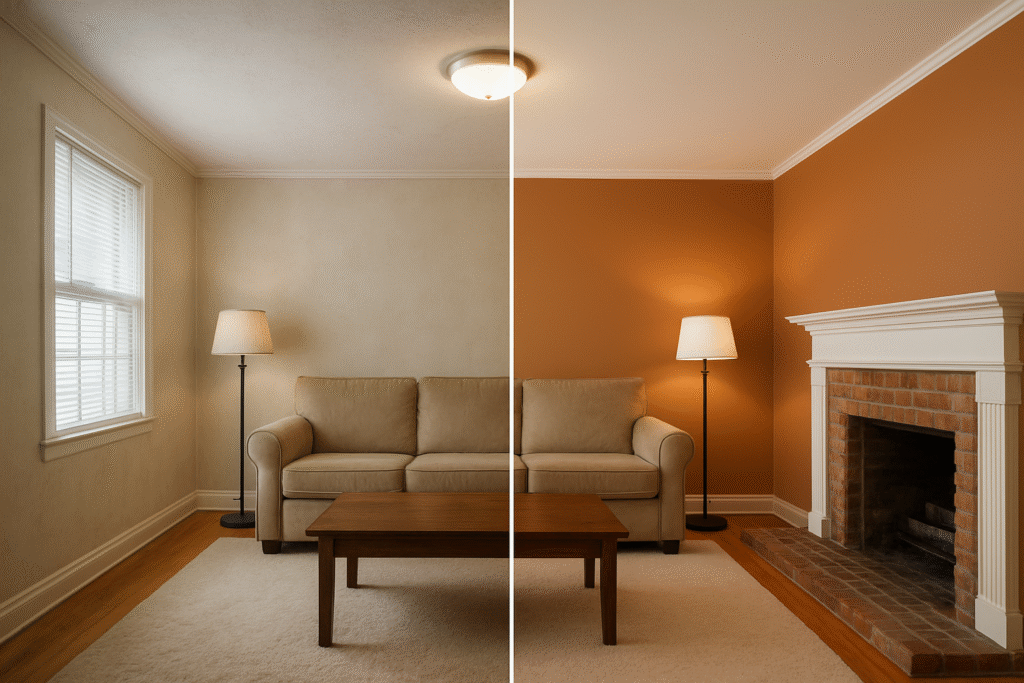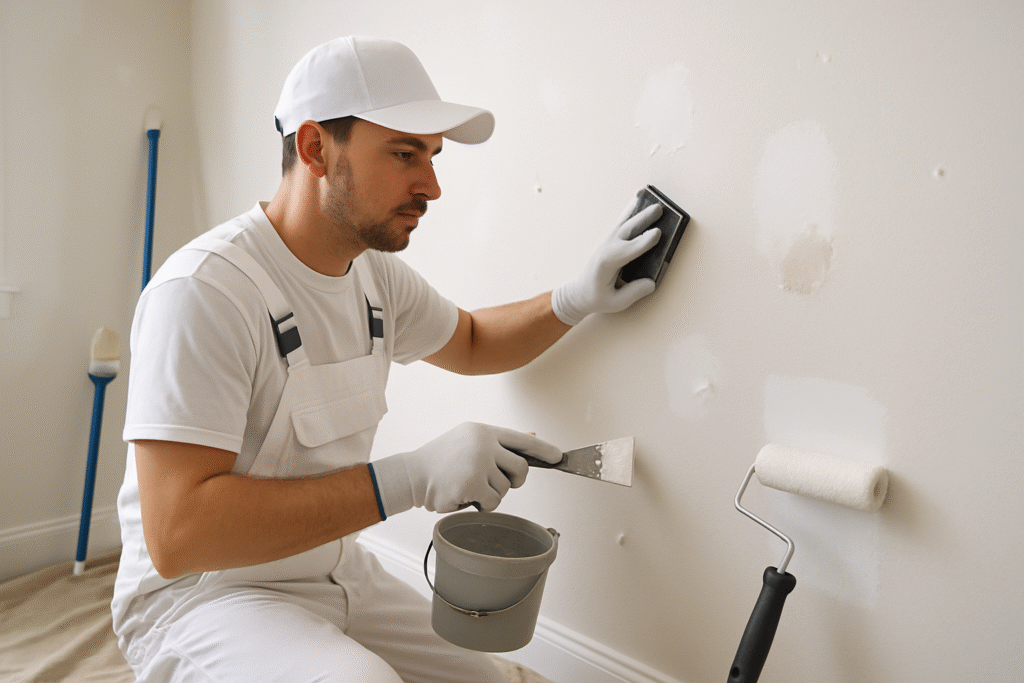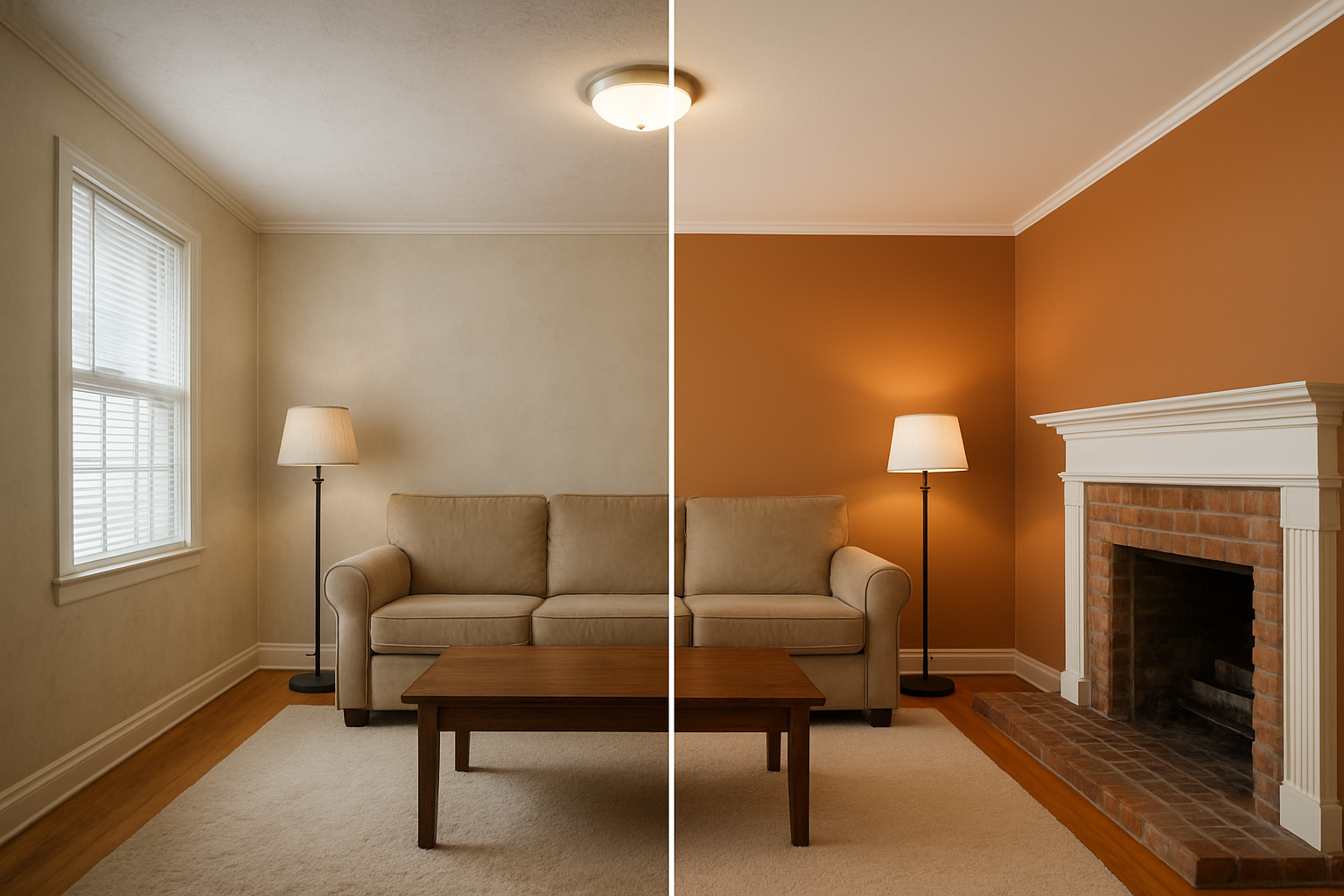Why Choosing the Right Interior Painter Matters
When it comes to transforming your home’s interior, few things have as much impact as a fresh coat of paint. Yet, finding the best interior painter in Boston MA can feel overwhelming. With countless contractors offering similar services, how do you know which one will deliver the quality, professionalism, and attention to detail your home deserves?
The truth is, not all painters are created equal. The difference between a mediocre paint job and an exceptional one often comes down to three factors: the painter’s skill and experience, their commitment to quality, and their understanding of your vision. A truly professional interior painter doesn’t just apply paint to walls—they prepare surfaces meticulously, protect your belongings, manage their time efficiently, and treat your home with the respect it deserves.
This comprehensive guide will walk you through everything you need to know about finding the best interior painter in Boston MA. Whether you’re looking to refresh a single room or transform your entire home, you’ll learn what separates the best painters from the rest, what questions to ask, and how to ensure you get exceptional results.
What Makes an Interior Painter “The Best”?
1. Professionalism and Attention to Detail
The hallmark of the best interior painters is their meticulous attention to detail. This goes far beyond simply applying paint evenly. True professionals understand that the quality of the finished product depends on preparation, precision, and care at every stage of the process.
What to look for:
- Proper wall preparation (sanding, filling, priming)
- Clean, straight paint lines and edges
- No drips, runs, or uneven coverage
- Careful protection of floors, furniture, and fixtures
- Thorough cleanup after the job is complete
When you hire the best interior painter in Boston MA, you’re not just paying for paint application—you’re investing in a professional who understands that the details matter. They’ll spend time protecting your belongings, ensuring proper ventilation, and taking pride in every square inch of work.

2. Quality Materials and Techniques
Professional interior painters use premium materials and proven techniques that produce superior, longer-lasting results. They understand the difference between various paint types, finishes, and brands, and they know which products work best for different applications.
Quality indicators:
- Use of premium, name-brand paints
- Proper primer selection for different surfaces
- Application of multiple coats when necessary
- Knowledge of paint finishes (matte, eggshell, satin, semi-gloss, gloss)
- Understanding of how different finishes perform in different rooms
The best painters invest in quality materials because they know it directly impacts the longevity and appearance of their work. They’re not looking for the cheapest option—they’re looking for the best value, which means paint that will last longer, look better, and maintain its color and finish over time.
3. Excellent Communication and Project Management
Outstanding interior painters excel at communication. They listen to your vision, ask clarifying questions, provide honest recommendations, and keep you informed throughout the project.
Communication best practices:
- Clear, detailed estimates that break down costs
- Honest assessment of what’s possible and what’s not
- Regular updates during the project
- Willingness to address concerns promptly
- Professional, courteous interactions with homeowners
When you’re working with the best interior painter in Boston MA, you’ll feel heard and respected. They’ll take time to understand your color preferences, discuss options, and explain their recommendations. They’ll also be transparent about timelines, potential challenges, and costs.
4. Proper Licensing, Insurance, and Credentials
The best interior painters in Boston MA are properly licensed, insured, and bonded. This protects you in case of accidents, property damage, or disputes. It also indicates that the painter is serious about their business and committed to maintaining professional standards.
What to verify:
- Valid Massachusetts painting license
- Current liability insurance
- Workers’ compensation insurance
- Bonding (if applicable)
- Positive references from previous clients
- Membership in professional organizations
Never hire an unlicensed or uninsured painter, no matter how competitive their quote. The small amount you might save isn’t worth the risk to your home and your legal standing.
5. Proven Track Record and Positive Reviews
The best interior painters have a strong reputation built on years of satisfied customers. They’re not afraid to share references, show before-and-after photos, and display customer testimonials.
Reputation indicators:
- High ratings on Google, Yelp, and Angie’s List
- Positive customer testimonials and case studies
- Before-and-after portfolio showcasing diverse projects
- Years of experience in the Boston area
- Willingness to provide references
When researching interior painters in Boston, take time to read reviews carefully. Look for patterns in feedback—are customers consistently praising their attention to detail? Do they mention how the painter protected their home? Are they satisfied with the timeline and cost? These patterns reveal a lot about a painter’s true quality and professionalism.
How to Find the Best Interior Painter in Boston MA
Step 1: Start with Local Research
Begin your search by looking for interior painters specifically in the Boston area. Local painters understand the unique challenges of Boston homes—from older colonial-style houses to modern condos—and they’re familiar with local building codes and seasonal considerations.
Where to search:
- Google Maps and Google Business profiles
- Yelp and Angie’s List
- HomeAdvisor and Thumbtack
- Local business directories
- Referrals from friends, family, and neighbors
- Your real estate agent or property manager
When searching online, use specific keywords like “best interior painter Boston MA,” “professional painting contractor Boston,” or “interior painting services Boston.” These searches will help you find painters with strong local presence and positive reviews.
Step 2: Evaluate Credentials and Experience
Once you’ve identified several candidates, take time to verify their credentials and learn about their experience. A painter with 10+ years of experience in the Boston area has likely encountered and successfully handled a wide variety of projects and challenges.
Questions to ask:
- How long have you been painting in the Boston area?
- Are you licensed and insured in Massachusetts?
- Can you provide references from recent projects?
- What types of projects do you specialize in?
- How do you handle unexpected issues or complications?
Don’t hesitate to ask for references and actually contact them. Ask previous clients about their experience, the quality of work, how the painter handled their home, and whether they’d hire them again.
Step 3: Review Portfolios and Before-and-After Photos
The best interior painters are proud of their work and happy to show it off. Ask to see a portfolio of recent projects, including before-and-after photos. Pay attention to the variety of projects, the quality of the finished work, and the attention to detail visible in the photos.
What to look for in portfolios:
- Variety of room types (bedrooms, living rooms, kitchens, bathrooms)
- Different color choices and finishes
- Clean, professional application
- Proper edge work and trim painting
- Evidence of proper surface preparation
If a painter is reluctant to show you their work or only has a few examples, that’s a red flag. The best interior painters have plenty of examples to choose from and are eager to showcase their quality.
Step 4: Get Multiple Quotes and Compare
Never hire the first painter you contact. Instead, get quotes from at least three different painters. This allows you to compare pricing, services, and professionalism.
What to include in your quote request:
- Detailed description of the project (rooms, square footage, current condition)
- Specific paint colors and finishes you’re considering
- Any special requests (protection of furniture, specific timeline, etc.)
- Request for itemized breakdown of costs
When comparing quotes, don’t automatically choose the lowest price. Instead, consider the overall value—the painter’s experience, the quality of materials they use, their communication style, and their timeline. Sometimes paying a bit more for a superior painter is the best investment you can make.

Step 5: Assess Communication and Professionalism
Pay attention to how each painter communicates with you during the quote process. Are they responsive to your calls and emails? Do they answer your questions thoroughly? Do they seem genuinely interested in understanding your vision? Do they provide professional, detailed estimates?
The way a painter treats you during the quote phase is usually a good indicator of how they’ll treat you during the actual project. If they’re dismissive or vague now, they likely will be during the job as well.
Step 6: Check References and Reviews
Before making your final decision, take time to thoroughly check references and read reviews. Contact at least two references provided by the painter and ask specific questions about their experience.
Questions to ask references:
- How satisfied are you with the quality of the paint job?
- Did the painter respect your home and protect your belongings?
- How well did they communicate throughout the project?
- Were there any issues, and how did the painter handle them?
- Would you hire this painter again?
- What was your experience with the timeline and cost?
Also, read online reviews carefully. Look for patterns in feedback and pay special attention to how the painter responds to negative reviews. A professional painter will address concerns respectfully and work toward resolution.
Red Flags: What to Avoid When Hiring an Interior Painter
1. Unlicensed or Uninsured Painters
This is the biggest red flag. Never hire a painter who can’t provide proof of licensing and insurance. Unlicensed painters may offer lower prices, but they’re not held to professional standards, and you have no recourse if something goes wrong.
2. Vague or Incomplete Estimates
A professional painter provides detailed, itemized estimates that clearly break down labor, materials, and any additional costs. If an estimate is vague or seems too good to be true, it probably is.
3. Pressure to Pay Upfront
While it’s normal for a painter to request a deposit (typically 25-50%), be wary of anyone who demands full payment upfront. A reputable painter will have a payment schedule tied to project milestones.
4. No References or Portfolio
If a painter can’t or won’t provide references or show you examples of their work, that’s a major warning sign. The best interior painters are proud of their work and eager to demonstrate their quality.
5. Poor Communication
If a painter is difficult to reach, doesn’t return calls or emails promptly, or seems uninterested in understanding your vision, move on. Communication is crucial to a successful project.
6. Extremely Low Prices
While everyone wants a good deal, extremely low prices often indicate cut corners—cheaper materials, rushed work, or lack of proper preparation. Remember, you get what you pay for.
7. No Written Contract
Always insist on a written contract that clearly outlines the scope of work, timeline, payment schedule, materials to be used, and warranty information. A verbal agreement is not sufficient.

Questions to Ask Before Hiring Your Interior Painter
Before making your final decision, ask these important questions:
About Experience and Credentials:
- How long have you been painting in Boston?
- Are you licensed and insured in Massachusetts?
- Can you provide references from the last 3-5 projects?
- What’s your specialty—residential, commercial, or both?
About the Project: 5. What’s your process for preparing walls before painting? 6. What brand and quality of paint do you use? 7. How many coats will you apply? 8. How will you protect my furniture and floors? 9. What’s your timeline for this project? 10. How do you handle unexpected issues or complications?
About Cost and Payment: 11. Can you provide an itemized estimate? 12. What’s your payment schedule? 13. Do you offer any warranty on your work? 14. Are there any additional costs I should know about?
About Communication: 15. How will you keep me updated during the project? 16. What’s the best way to reach you if I have questions? 17. How do you handle change requests or modifications?
The Interior Painting Process: What to Expect
Understanding what to expect during the painting process will help you evaluate whether your painter is following professional standards.
Pre-Project Preparation
The best interior painters invest significant time in preparation. This includes:
- Surface inspection: Checking walls for damage, stains, or issues that need attention
- Wall preparation: Sanding rough spots, filling holes, and patching damaged areas
- Priming: Applying primer to ensure proper paint adhesion and coverage
- Protection: Covering floors, furniture, and fixtures to prevent paint drips and spills
- Color consultation: Discussing color choices and finishes with you
During the Project
Throughout the painting process, expect:
- Professional work practices: Proper ventilation, safe ladder use, and clean work habits
- Regular communication: Updates on progress and any issues that arise
- Attention to detail: Careful edge work, straight lines, and even coverage
- Minimal disruption: The painter respects your home and minimizes inconvenience
- Daily cleanup: The work area is kept clean at the end of each day
Post-Project
After the painting is complete, the best painters will:
- Thorough cleanup: Remove all protective coverings, clean up spills, and dispose of materials properly
- Final walkthrough: Review the work with you to ensure satisfaction
- Touch-ups: Address any minor imperfections or areas that need attention
- Warranty information: Provide details about any warranty on their work
- Maintenance tips: Offer advice on caring for your newly painted surfaces
2025 Interior Painting Trends in Boston
If you’re considering a fresh paint job, you might be interested in current design trends. Here are some of the most popular interior painting trends for 2025:
Warm, Earthy Hues
Warm, natural colors continue to dominate interior design. Think warm neutrals, terracotta, ochre, and soft browns. These colors create a sense of comfort and connection to nature.
Matte Finishes
Matte finishes are increasingly popular for interior walls. They provide a sophisticated, modern look and help hide imperfections better than glossy finishes.
Sage Green
Soft, muted greens like sage are trending for bedrooms and living spaces. These calming colors work well with natural materials and create a spa-like atmosphere.
Bold Accent Walls
While neutral walls remain popular, bold accent walls are making a comeback. Deep blues, rich greens, and warm terracottas create visual interest and define spaces.
Color Drenching
Color drenching—painting an entire room, including trim and ceiling, in the same color—creates a cohesive, enveloping effect that’s very on-trend.
Muted, Saturated Colors
Rather than bright, neon-like colors, 2025 favors muted, saturated tones that feel sophisticated and timeless.
When discussing these trends with your interior painter, they should be able to offer recommendations based on your home’s style, lighting, and your personal preferences.

How to Maintain Your Newly Painted Interior
Once you’ve invested in professional interior painting, you’ll want to protect that investment. Here are some maintenance tips from professional painters:
Immediate Care (First 30 Days)
- Allow paint to cure fully before washing or scrubbing walls
- Avoid hanging pictures or heavy items for at least a week
- Ensure proper ventilation to help paint cure faster
- Keep humidity levels moderate
Long-Term Maintenance
- Dust walls regularly with a soft cloth
- Clean marks and stains promptly with appropriate cleaners
- Avoid harsh scrubbing that could damage the paint finish
- Touch up minor scuffs and marks as needed
- Repaint every 5-10 years, depending on traffic and conditions
Room-Specific Considerations
Kitchens and Bathrooms: These high-moisture areas may need semi-gloss or satin finishes that resist moisture and are easier to clean.
Bedrooms and Living Rooms: Matte or eggshell finishes work well in these lower-traffic areas.
Hallways and Entryways: Consider more durable finishes in high-traffic areas.
Why Professional Interior Painting is Worth the Investment
You might be tempted to tackle interior painting yourself or hire the cheapest contractor you can find. However, investing in professional interior painting offers significant benefits:
Superior Quality and Durability
Professional painters use quality materials and proven techniques that produce superior, longer-lasting results. Their work will look better and last longer than DIY attempts.
Time and Convenience
Professional painters complete projects efficiently, minimizing disruption to your daily life. What might take you weeks to do yourself, a professional can accomplish in days.
Expertise and Problem-Solving
Professional painters have encountered virtually every painting challenge and know how to solve them. They can recommend solutions for problem areas and ensure the best possible outcome.
Protection of Your Home
Professional painters protect your home and belongings during the project. They understand how to properly prepare surfaces, protect floors and furniture, and clean up thoroughly.
Peace of Mind
When you hire a professional interior painter, you get peace of mind knowing the job will be done right. Most reputable painters offer warranties on their work.
Conclusion: Finding the Best Interior Painter in Boston MA
Finding the best interior painter in Boston MA requires research, careful evaluation, and clear communication about your expectations. By following the steps outlined in this guide—researching credentials, reviewing portfolios, getting multiple quotes, and checking references—you’ll be well-equipped to make an informed decision.
Remember, the best interior painter isn’t necessarily the cheapest. Instead, look for a professional who demonstrates expertise, attention to detail, excellent communication, and a commitment to quality. Someone who treats your home with respect, protects your belongings, and takes pride in their work.
When you hire the right interior painter, you’re not just getting a fresh coat of paint. You’re investing in the beauty, value, and comfort of your home. You’re getting a professional who understands that the details matter and who will work tirelessly to ensure your complete satisfaction.
Whether you’re refreshing a single room or transforming your entire home, take the time to find the best interior painter in Boston MA. Your home deserves nothing less.
Ready to Transform Your Home?
If you’re looking for a professional interior painter in Boston MA who embodies all the qualities discussed in this guide—expertise, attention to detail, quality materials, excellent communication, and a commitment to your satisfaction—we’d love to help.
Boston Paint & Power specializes in residential interior painting with a focus on meticulous preparation, premium materials, and exceptional customer service. We understand that your home is important to you, and we treat it with the care and respect it deserves.
Contact us today for a free consultation and estimate. Let’s transform your home together.

